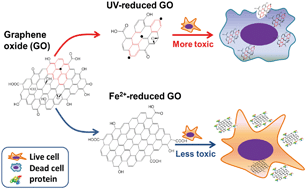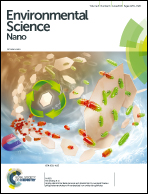Reduction pathway-dependent cytotoxicity of reduced graphene oxide†
Abstract
The environmental transformation of graphene oxide (GO) can significantly change its physicochemical properties, thus altering its toxicity. Here, we demonstrated how exposure to simulated sunlight or reduction with ferrous iron (Fe2+, an environmentally abundant and mild reductant) significantly impacts the cytotoxicity of GO. GOs were reduced under both sets of conditions, but the Fe2+-reduced GO showed dramatically lower cytotoxicity than did the light-reduced GO. A highly reactive graphene-based radical was generated when GO was exposed to light, and this radical significantly contributed to cell membrane oxidation. Moreover, light-induced reduction promoted breakage of the graphene sheet, decreasing the lateral size and increasing the ability of the material to disrupt the membrane, which consequently enhanced cellular uptake. Interestingly, we observed a loss of C–O–C/C–O groups but an increase in C![[double bond, length as m-dash]](https://www.rsc.org/images/entities/char_e001.gif) O/O–C
O/O–C![[double bond, length as m-dash]](https://www.rsc.org/images/entities/char_e001.gif) O groups during Fe2+ reduction; these alterations improved the radical quenching capacity of the material due to the restored sp2 structure and the increase in electron-shuttering groups. Reduction-induced aggregation significantly decreased cellular uptake relative to the internalization of the parent GO. These results emphasize that environmental transformation-induced property changes should be given adequate consideration in the risk assessment of GO.
O groups during Fe2+ reduction; these alterations improved the radical quenching capacity of the material due to the restored sp2 structure and the increase in electron-shuttering groups. Reduction-induced aggregation significantly decreased cellular uptake relative to the internalization of the parent GO. These results emphasize that environmental transformation-induced property changes should be given adequate consideration in the risk assessment of GO.



 Please wait while we load your content...
Please wait while we load your content...